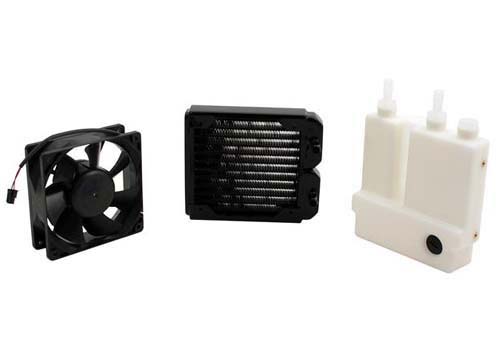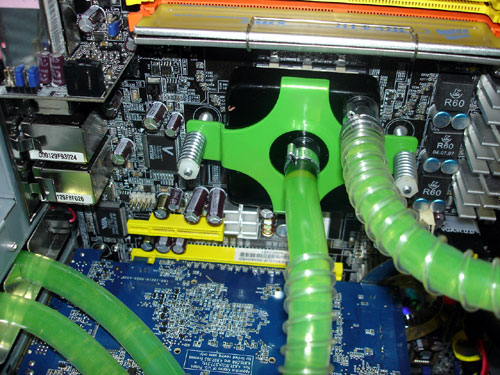Corsair COOL Water Cooling
Impression


Opening the package, you can tell immediately that Corsair put a lot of time and effort into this product. The components are individually packaged in a soft foam casing for protection. There is no possible way that anything here could be damaged. Once I got past the packaging, the first thing I noticed was an incredibly strong resemblance to the Swiftech H2O-120 (Rev 3) water cooling kit. The only real difference is the use of 3/8′ tubing as opposed to 1/2″, a 240 pin CPU block instead of a 281 pin block, and the absence of Swiftech’s quick connect system, and a few cosmetic changes. As a side note, it turns out this whole resemblance to the Swiftech kit is not my imagination:
“Corsair develops and builds the highest performing water cooling kits on the market. We select the combination of components that together deliver optimum cooling. We have partnerships with and source components from industry leaders like Delphi and Swiftech. Our new 120mm COOL kit was co-developed with Swiftech, and both companies sell similar versions of the same core kit.”
In the end it really doesn’t matter to me. I have used a lot of Corsair products and have never been disappointed.
CPU block

Corsair chose to use 3/8 ID (1/2OD) tubing and barbs for the “Cool system”. The inlet barb is placed directly in the center of the block, over the hottest part of the processor, while the outlet barb is placed over the corner of the block. The copper CPU block features a unique 240 pin design which causes turbulence within the moving water, dissipating heat more rapidly, the Swiftech block offers a 281 pin block, though I don’t think the extra 41 pins will make a huge difference in performance. The base of the all copper CPU block is a common design, square in shape and approximately 2.5″ x 2.5″ in size. While the base itself was not polished like others on the market I did not notice any machine marks or unevenness. While not a mirror like surface, I doubt the finish will impact this blocks performance at all. Corsair chose to use permanent clamps to connect the tubing to the block’s barbs. I like this because it eliminates the possibility of the user connecting something wrong or not clamping a tube down, causing leaks. I don’t like this because by permanently affixing the tubing, Corsair limits future installations or additions to the system.
Pump
The 12V Delphi’s DC pump Corsair chose to run their Cool system is the smallest and quietest pump I have ever seen! The pump is completely plug-and-play and connects directly to any computer power-supply through a standard 4 pin power molex. It’s compact design, quiet and powerful motor make it ideally suited for heavy duty cooling in environments where space is at a premium. The size and shape of this pump, coupled with mounting holes and a thick neoprene pad mean that even in the most cramped case, you should have no problem mounting it. I had no problem finding several different locations to secure the pump.

I’m a big fan of 12V pumps and I have to say after setting up the Corsair Cool and firing up this pump, I was blown away by its noise level and overall performance.
Features
| Delphi Pump Technical Data |
|
| Design Advantages |
|

Comments are closed.